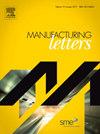根据珠子几何形状估算 L-DED 输入工艺参数的分析模型
IF 2
Q3 ENGINEERING, MANUFACTURING
引用次数: 0
摘要
通过激光定向能沉积(L-DED)技术对金属合金进行增材制造越来越受欢迎,因为它具有修复和创建新特征/部件的潜力,能为制造的部件带来新的应用。L-DED 操作的成功取决于对打印参数的精确控制,包括激光功率、扫描速度和粉末进给速度。这些参数对打印过程中的热量分布有很大影响,直接影响到成品部件的质量。因此,定义一种有效的方法来找到这些参数在打印过程中的良好相关性,对于提高零件产量至关重要,因为它可以减少耗时的试错参数调整过程。在此背景下,我们的研究引入了一个分析模型,该模型可根据沿轨迹线沉积的材料体积预测打印参数。我们在不锈钢 316L 上进行了沉积,并采用了不同的激光功率值(从 500W 到 750W,以 50W 为增量)、扫描速度(从 400mm/min 到 700mm/min,以 100mm/min 为增量)和粉末进给速度(6.4、8.0 和 10.0g/min)。实验数据验证了所提模型的有效性,表明该模型具有标准化第一步印刷过程的潜力,并能加快 L-DED 最佳印刷参数的初步搜索。该模型提供了精确的激光功率初始估计值,最大相对误差为 12%,尤其是在最佳质量流量 (ṁ) 为 8.0g/min 时。除了对 L-DED 工艺的益处之外,该分析解决方案还提供了一种预测打印过程中材料沉积量的有效方法,从而为实验实践做出了贡献。因此,我们的工作强调了优化印刷参数以获得高质量零件的重要性,并为 L-DED 领域未来的研究提供了宝贵的参考。本文章由计算机程序翻译,如有差异,请以英文原文为准。
An analytical model for estimating process parameters input in L-DED based on bead geometry
Additive manufacturing of metal alloys via laser Directed Energy Deposition (L-DED) has been gaining popularity due to its potential to repair and create new features/components, enabling new applications for built parts. The success of L-DED operations hinges on the precise control of printing parameters, including laser power, scanning speed, and powder feed rate. These parameters significantly influence heat distribution during printing, directly impacting the quality of the resulting parts. Thus, defining an efficient methodology to find a good correlation between these parameters for the printing process is crucial to boost part production, as it reduces the time-consuming trial-and-error parameter tuning process. In this context, our study introduces an analytical model that predicts printing parameters based on the deposited material volume along track lines. Deposition was carried in stainless steel 316L with different values for laser power (ranging from 500 to with increments), scanning speed (from 400 to with increments), and powder feed rate ( and ). The experimental data verified the effectiveness of the proposed model, demonstrating its potential to standardize the first step of printing process and expedite the initial search for optimal printing parameters in L-DED. The model provided accurate initial estimates of laser power, with a maximum relative error of , particularly for the optimum mass flow rate () of . Beyond its benefits to the L-DED process, this analytical solution contributes to experimental practices by offering an efficient method for predicting material deposition volume during printing. Thus, our work underscores the significance of optimizing printing parameters to achieve high-quality parts and provides a valuable reference for future research and studies in the field of L-DED.
求助全文
通过发布文献求助,成功后即可免费获取论文全文。
去求助
来源期刊

Manufacturing Letters
Engineering-Industrial and Manufacturing Engineering
CiteScore
4.20
自引率
5.10%
发文量
192
审稿时长
60 days
 求助内容:
求助内容: 应助结果提醒方式:
应助结果提醒方式:


